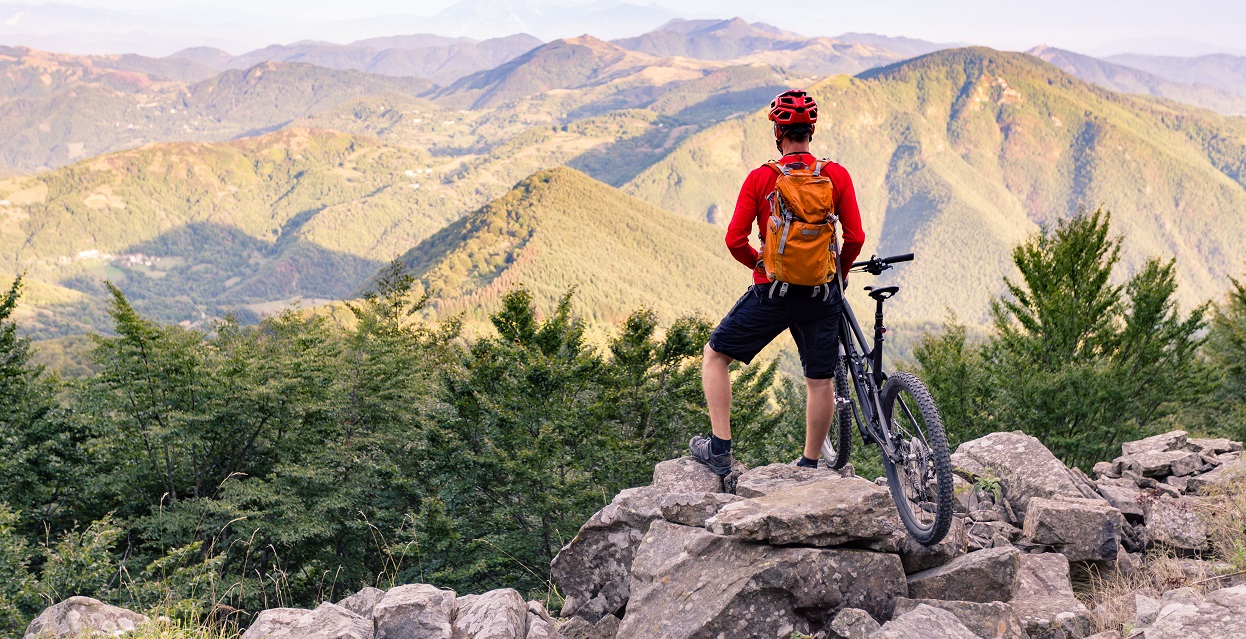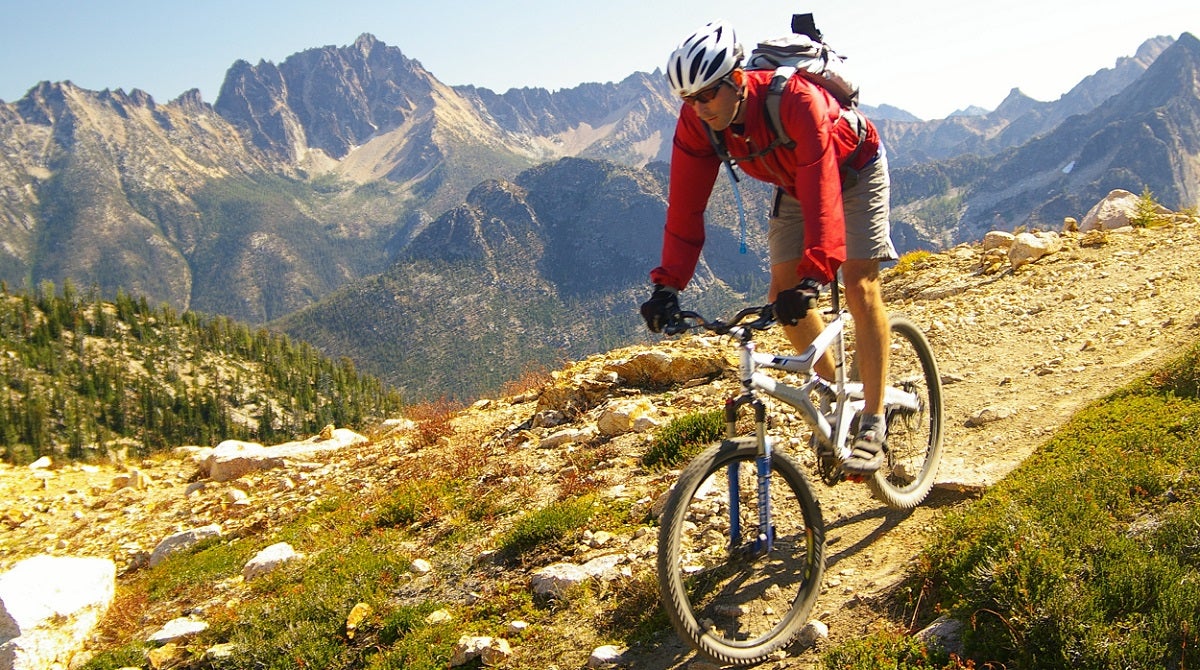
Our Editors independently research, test, and rate what we feel are the best products. We use affiliate links and may receive a small commission on purchases.
Choosing the right mountain bike can be tough. Regardless of if you are a beginner unsure of what bike to start with, or a more experienced rider looking for an upgrade, there are a huge number of options on offer. Making a decision can be a daunting process.
Unfortunately, it is not as simple as picking out a nice looking bike. There are all sorts of factors to consider, such as what kind of riding the bike is intended for, what components are needed, and, of course, budget. We have written this guide to help you find the perfect mountain bike for you.
The Anatomy of a Mountain Bike
A bicycle is a complex mechanical machine consisting of many components. Before looking at how mountain bikes differ for various riding styles, it is first important to be able to recognize the parts that make up a mountain bike.
Frame & Suspension
The frame is the heart and soul of every bicycle. The design of the frame defines many aspects of how the bike will behave. Frames come in one of two types. As opposed to a full-suspension frame, a hardtail frame has no rear suspension or moving parts.
An understanding of frame design gives you the ability to look at a frame geometry chart and understand what a bike will feel like on the trail without having ridden it.
Frame designers consider the length and angles of a frame (known as geometry) to define its ride characteristics. For example, short chainstays (the tube between the rear wheel axle and bottom bracket) will make a bike feel playful on the trail as it is easy to get the front wheel in the air.
A long wheelbase is good for stability at high speeds but makes getting around tight corners more difficult. The head angle refers to at what angle the fork extends from the frame. Slack head angles have been recognized as being better for descending.
It is possible to find both hardtail and full-suspension bikes for each style of riding. The exception is downhill bikes, which are never hardtails. Although rear suspension does make a bike more comfortable to ride, its primary purpose is traction and speed. Hardtails are lighter due to the simpler frame and lack of rear shock. Some people love riding hardtails even on rough and technical trails.
Bear in mind that a hardtail frame can be combined with either a suspension fork, or a rigid fork. Full-suspension bikes come with rear travel between 100mm and 200m and a fork of equal length or longer. More suspension means your bike can absorb bigger impacts and rougher trails.
Fork
The primary function of a fork is to hold the front wheel in place. A fork is attached through the head tube of the frame and the handlebar is clamped on at the top of the fork via a stem. In order to allow steering, the fork must be able to turn in the frame. Bearings at the top and bottom of the head tube allow this.
Forks can be rigid but most mountain bikes have a suspension fork. Suspension on a bike smoothes out the trail, allowing you to ride faster and enjoy better traction. Rigid forks do not absorb any pedalling energy and can be found on some XC bikes.
Wheels & Tires
Mountain bike wheels come in three diameters. 26” used to be the standard but modern bikes usually have 27.5” or 29” wheels. Some even have a combination. It is still possible to find 26” wheel bikes. Dirt jump bikes use 26”, as well as kids bikes, which can also be found with even smaller wheels.
Bigger wheels roll over obstacles easier but smaller wheels are more agile. Choosing a wheel size depends on what you want to ride, as well as your height. Tall riders usually prefer 29” wheels.
When it comes to tires, you are spoiled for choice. There are tires for all kinds of conditions and terrains, and they come in a variety of widths and casings. A new bike will, of course, come with tires fitted but you will probably want to swap them for a set to match your trail conditions.
One thing to look out for is if the wheels are set up tubeless or tubeless ready. A tubeless system means far fewer flat tires than you will get from using inner tubes.
Drivetrain
The drivetrain refers to everything that transfers power from your legs to the rear wheel to propel the bike forward. Cranks are connected through an axle called the bottom bracket, as well as one or more chainrings.
As the cranks are turned by leg power, a chain pulls one of the sprockets on the cassette, which turns the wheel. A derailleur moves the chain between sprockets.
Modern mountain bikes usually have a 1x setup. This means that there is one chainring and either an 11, or 12-speed cassette, referred to as 1×11, or 1×12. You may also find a 2×10 or 2×11 system. Older bikes have 3x system with 3×7 being the most common. The lack of a front derailleur on 1x drivetrains reduces weight and keeps shifting simple.
Brakes
Nearly all bikes these days come with powerful hydraulic disc brakes. We advise you to avoid any other types, including mechanical disc brakes. Once installed they are relatively maintenance free but will require bleeding now and again.
The most powerful brakes have four pistons in each caliper but two pistons is more than adequate unless you are into downhill or enduro racing. You can fine-tune braking power by installing bigger or smaller discs. A bigger disc equals more power. Learn more about brakes here.
Seatpost & Saddle
The saddle is what you sit on and it is connected to the frame with a seatpost. To really enjoy descents without the seatpost getting in the way, we recommend you find a bike with a dropper post. With the push of a button, you can lower the seat out of the way for a downhill section and raise it again when it is time to pedal. You can find out more about dropper posts here.
How to Choose the Right Mountain Bike for You
Now you know about the different parts of a bike, we can look at the various styles of mountain biking and the bikes that are used for them.
Please note that all of the following bike types can be found for a range of prices from entry-level to remarkably expensive. More expensive bikes come with lighter or better performing components that are attractive to racers and dentists but you do not need to break the bank to get a great bike.
Cross Country/XC
Cross country is all about racking up the miles on fire roads and easy trails. A XC bike is lightweight and built for speed, usually with 29” wheels and fast-rolling tires. A hardtail with a suspension fork is common, or full-suspension with no more than 100mm travel.
Some masochists like to have a rigid fork on their XC bike. 1x drivetrains are the most common setup and dropper posts are optional. Racers try to keep weight to the minimum but increasingly technical XC race circuits have encouraged the use of droppers.
Trail
A trail bike has a bit more suspension travel, between 100mm and 140mm, unless it is a hardtail, in which case it will have a 120mm or 140mm fork. Trail bikes can be taken anywhere and want to go on big adventures in the mountains.
Most trail bikes will have a 1x drivetrain but some can be found with 2x for extra range to get up really big and steep hills. Tires on a trail bike tend to have medium width and strength. A good trail bike will come with a dropper post or at least have internal routing for one.
Enduro
The difference between a trail bike and an enduro bike might not be too obvious to someone new to the sport. They are both full-suspension bikes that can easily be pedalled to the top of mountains. However, if you look closer, you will find that enduro bikes are longer, heavier, and have more suspension travel. The reason for this is that they are optimized for riding as fast as possible downhill.
There are hardtail enduro bikes but the most popular ones are full-suspension. 150mm to 180mm of suspension is the norm, a dropper post is a must and the brakes will have 4 pistons to grab hold of big discs. The tires are wide with deep tread for ultimate grip.
Fatbike
Imagine a monster truck but it is a bicycle. Big fat tires give these bikes their name, as well as ultimate grip on snow or sand. They are also fun on regular trails. Fatbikes can be fully rigid, hardtail, or full suspension with not too much suspension travel.
Bikepacking
It is possible to take any of the above bikes on a bikepacking adventure. All you need to do is strap some gear onto the frame and handlebars and your bike is ready to go (especially a trail bike). There are also bikepacking specific mountain bikes available with plenty of space for frame bags and many mounts for bottle cages or other accessories. For a couple of days in the wild, your regular bike is fine. If you are thinking of a serious long-distance adventure, you will be best off with a purpose-built bike. Check out this article to learn more about what you need for a bikepacking trip.
Downhill
These bikes are for smashing out laps in the bike park or racing downhill. You will not be able to pedal a downhill bike back to the top. These things are burly beasts with big strong frames, long suspension travel, and the most powerful brakes possible.
Kids Bikes
XC, trail, and enduro bikes can be found in kids’ sizes. It is best to start very young ones off on a balance bike, before moving them on to bikes with gears. Kids grow fast. Fortunately, there are bikes available for 4-5 year-olds once they have outgrown balance bikes, as well as mountain bikes for older kids as well.
Ebikes
With the exception of bikepacking bikes, you can find ebike versions of all the above. The main advantage of an ebike is that you can cover more ground in the same time or get to the top of a mountain faster. Ebikes are not permitted on all trails so do check this before a ride, especially in new locations.
So which mountain bike is best for you? Well, it depends. If you are new to mountain biking then you are probably best off with a 120mm, 140mm, or 150mm trail bike. An enduro bike will work for you as well but will probably be “too much” bike for you at this stage. If you do not intend to ride particularly steep or technical trails, then a XC bike would be a good option. Have a look at our recommendations for beginner mountain bikes here.
If you have been riding for a while and want a different type of bike then you probably know already what you are after. Want to focus on fitness and training? Then get yourself a XC bike. Maybe you feel confident on the trails already and want to upgrade to an enduro bike to take your riding to the next level.

